60% dairy farmers failed to get a fair price during the lockdown: Gaon Connection survey
60% dairy farmers complained of low prices for milk while 53% the respondents found it difficult to find buyers as markets, shops, hotels remained closed during the lockdown, resulting in losses of millions of rupees in this sector.

Abhishek Singh, a dairy farmer from Kaimur district in Bihar, had to sell four of his seven cattle during the lockdown following the COVID19 pandemic, as he was unable to sell the milk.
“Milk was being produced as usual but the sweet shops which bought our milk remained shut during the lockdown and the demand reduced considerably. Unable to sell the milk, I found it very difficult to feed my animals,” Singh told Gaon Connection adding that he was forced to sell four of his seven cattle.
The nationwide lockdown brutally affected almost all segments of the society. The dairy sector was hit as early as March 22, losing crores of rupees, a Gaon Connection survey found. With demand for milk plunging and fodder prices escalating, many dairy farmers incurred huge losses and were forced to sell their cattle, a survey of dairy farmers by Gaon Connection said.
The survey said 56 per cent of people in the dairy business had difficulty in delivering milk to the market, while 42 per cent did not face any problem and three per cent did not respond. Fifty three per cent of the respondents had difficulty in finding customers, while 40 per cent said they had no problem and eight per cent did not respond.
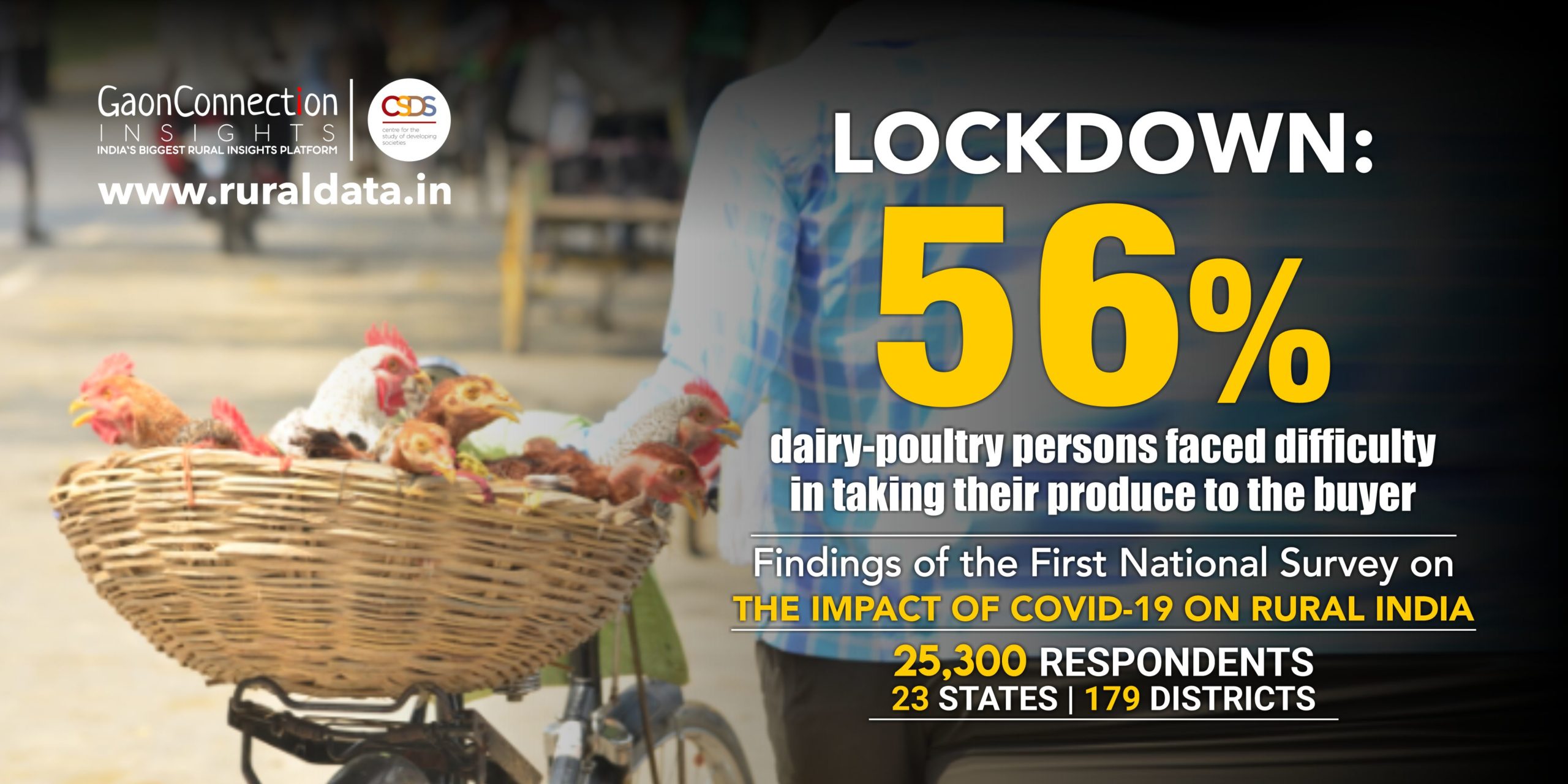
About 984 kms from Kaimur, Manish Bharti, the largest dairy farmer in Meerut district of Uttar Pradesh, owns 80 cows that produce 300-350 litres of milk every day. However, he found it very challenging to sell his milk yield due to the lockdown.
“I have not yet fully recovered from the losses that I suffered. So much milk was produced and supplied each day when suddenly everything came to a standstill. I also supply a small part of my yield to cooperative dairies like Parag. Even they reduced the rate during the lockdown after demand fell.” Bharti told Gaon Connection.
Fall in consumption led the government cooperatives to reduce the price of milk procured from the dairy farmers.
Gaon Connection’s countrywide survey was undertaken to understand the impact of the COVID-19 lockdown on the life and business in rural areas and how people were managing their livelihood in this difficult time. In the survey conducted among 25,371 rural people across 179 districts of 20 states and 3 union territories from May 30-July 16, 2020, farmers as well as dairy farmers and traders spoke about their difficulties.
With the closure of market during lockdown, sweet shops, hotels and restaurants, which were major buyers of milk or milk products also shut down. Although the supply of milk was reinstated from the second of the lockdown, there was hardly any sale of milk products like khoya, paneer, dahi, buttermilk or milk based sweets.
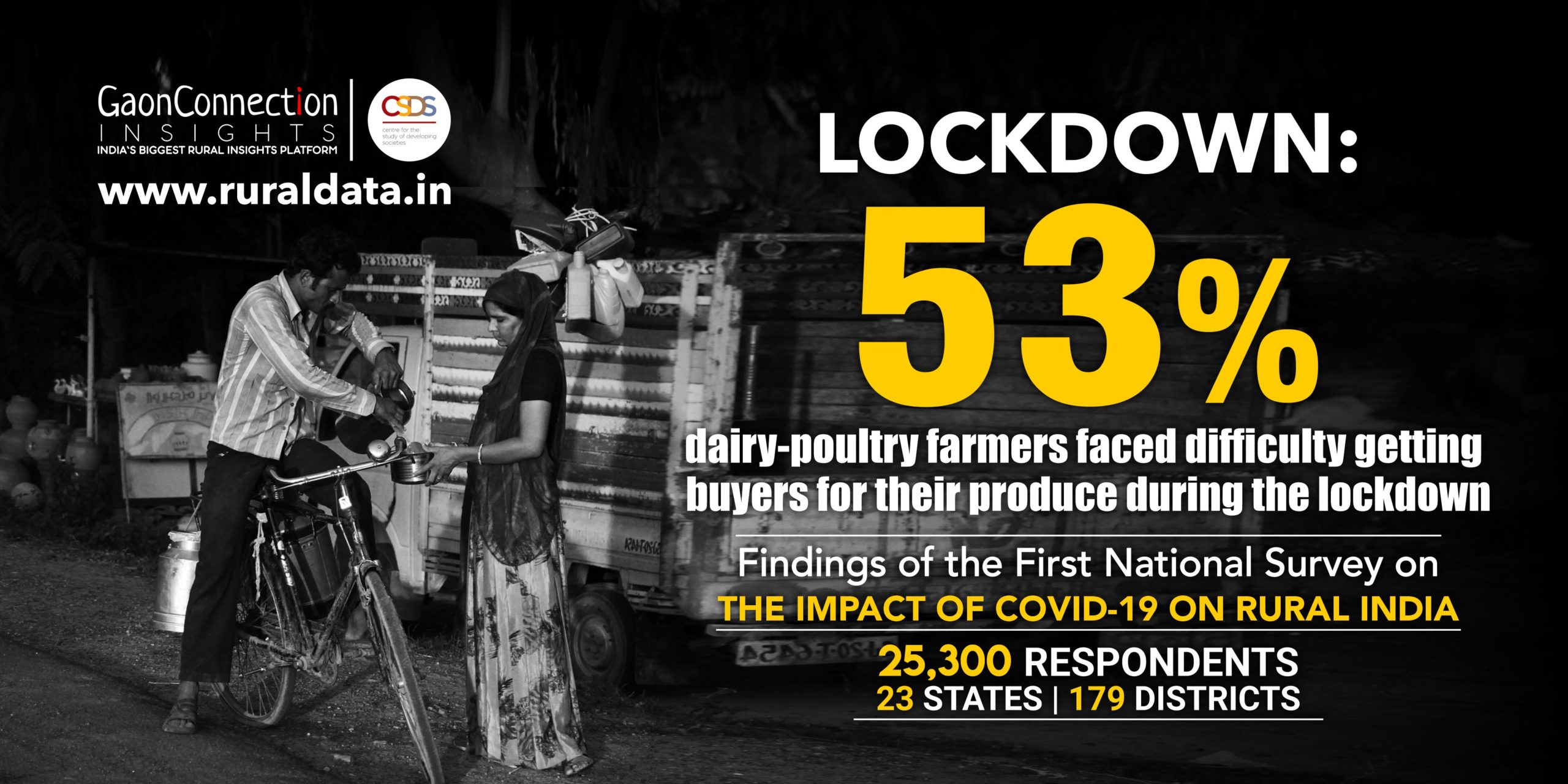
Malwa’s well know Mohan Peda in Fatehpur district of Uttar Pradesh, used to buy 250-300 litres of milk daily until the lockdown. During the festival, its demand for milk used to jump up to 500-600 litres but presently it hardly uses 30-40 litres a day. “The small dairy farmers in the locality come to us with their milk and our business used to support dozens of families. However, we as well as the dairy farmers have suffered a lot in the lockdown. Whether milk or the sweets made from milk, these products are perishable and have a limited shelf life,” lamented Naresh Gupta, owner of Mohan Peda.
The daily business had also been impacted by millions of people returning to their villages from cities. Although the markets had opened up in the first unlock, the fear of Corona virus has led to people buying fewer eatables from the markets adversely affecting the dairy industry.
“The festival time is upon us, we used to normally begin our preparations several days before but this time very little peda is being made. Despite the unlock, people are hesitant to buy our pedas, “Gupta said.
Deepak Khatwani from Kanker district of Chhattisgarh has been in the dairy business for three decades but never suffered so much difficulty as now. “The closure of the market during the lockdown halted our milk supply to hotels. Milk is a perishable commodity and cannot be stored so we were compelled to sell it as low as Rs 15 a litre,” Khatwanit told Gaon Connection.
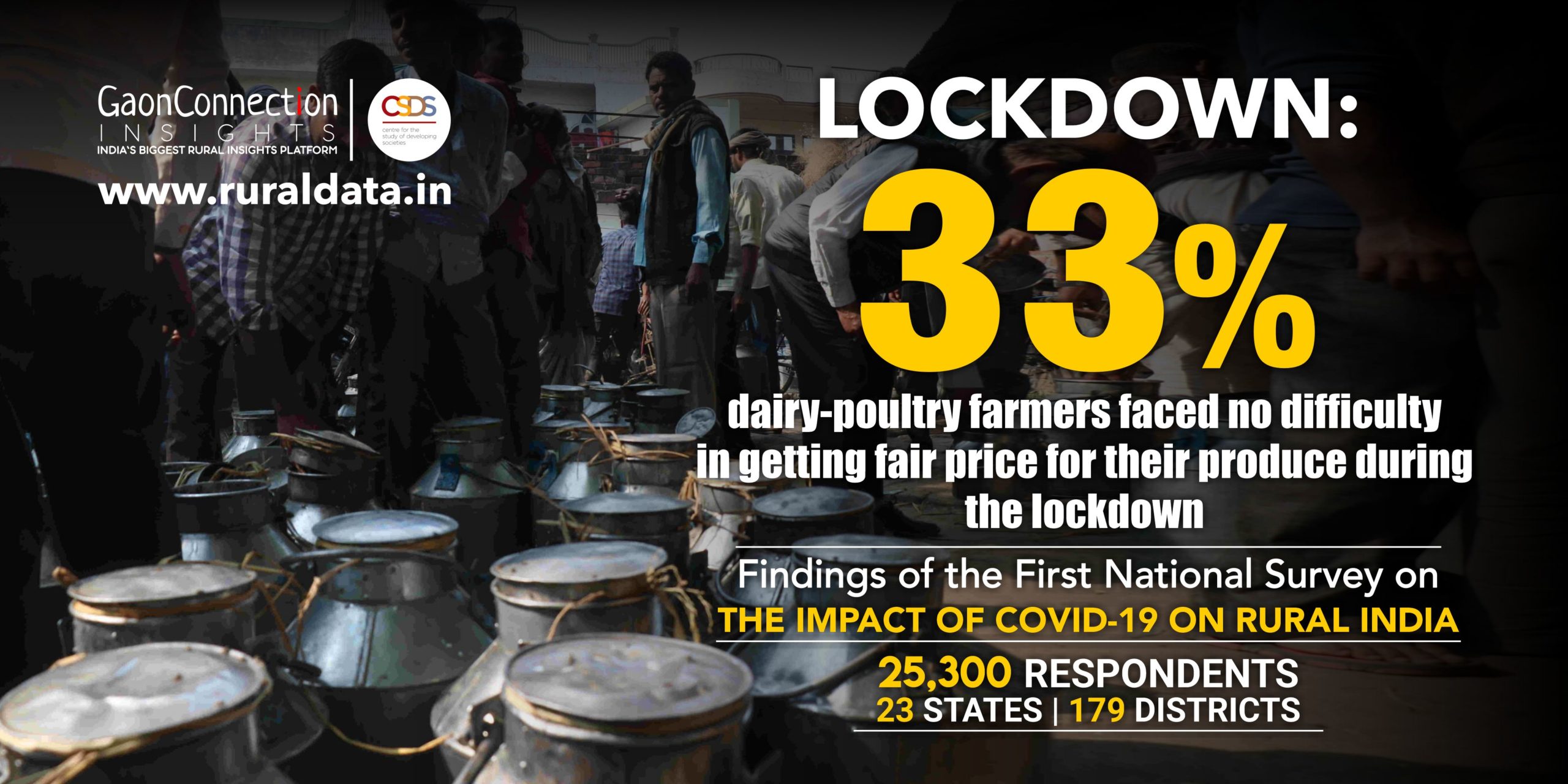
The Gaon Connection survey found that 60 per cent of the people in dairy business failed to get a fair price, while 33 per cent faced no problems. Three per cent did not respond. “Although the milk production had continued, its sale had been affected. I sold milk to the dairies at a very low rate,” Sohan Singh Patel, a farmer from Dewas district of Madhya Pradesh, said.
India has been leading the world in milk production for the last two decades. India produces 20 per cent of the world’s milk output.
“During the lockdown,milk prices nosedived, we were forced to sell milk for Rs 25-30 rupees a litre. The situation has not inproved so far,” Tarun Ghosh, a dairy farmer at Karimpur in Nadiya district of West Bengal, said.
Small, marginal and landless farmers have a stake of about 75% in India’s milk production. There are about 10 crore dairy farmers in India. According to the 20th Animal Census, the number of milch animals (cow-buffaloes) in the country is 12.53 crore.
From the second and third day of the lockdown, there had been reports from several states, including Karnataka, anguished farmers poured milk on the road in a sign of anguish. In certain parts of Punjab, farmers distributed milk in langars.
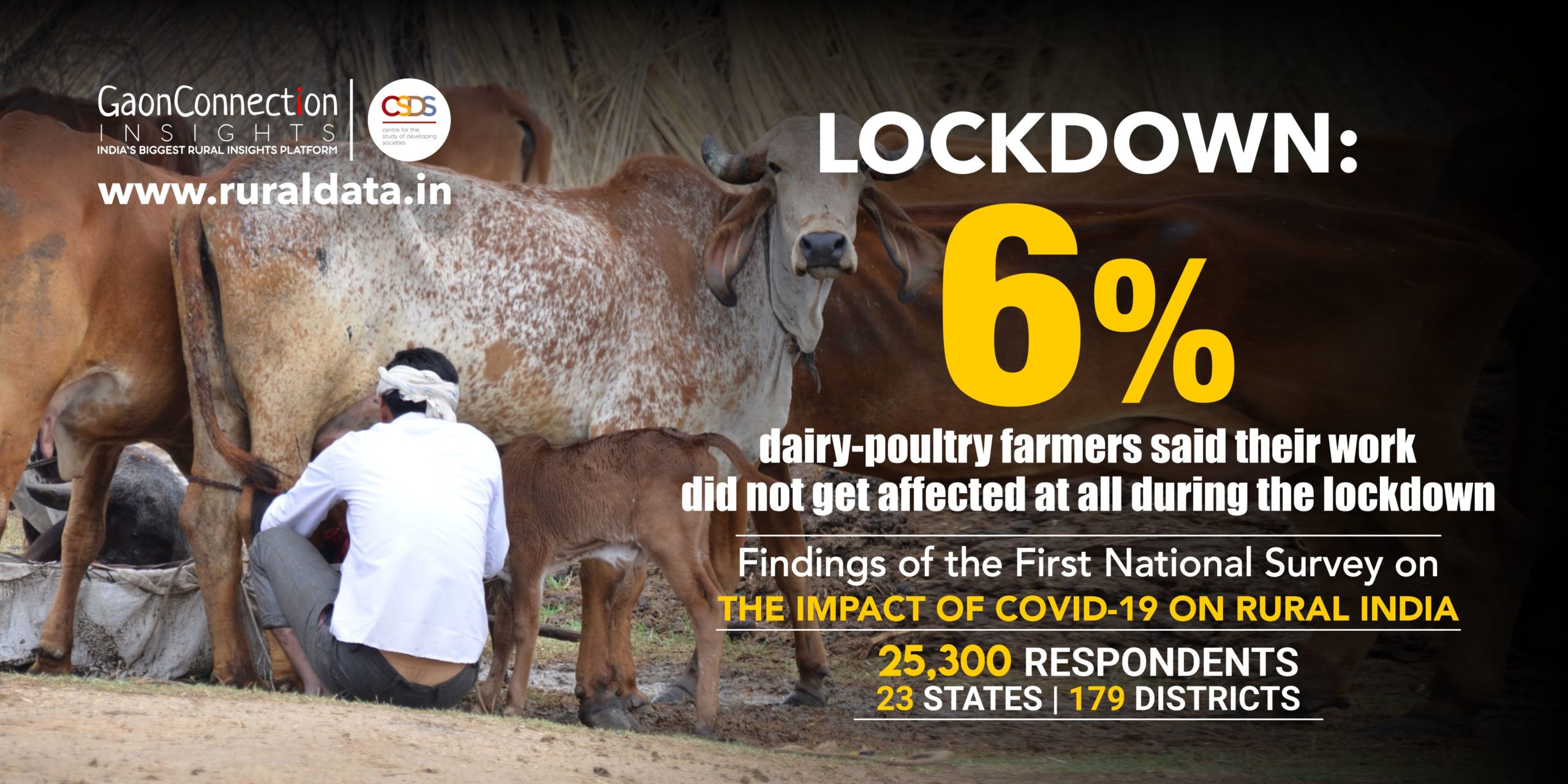
According to the Gaon Connection survey, 35 per cent of the people admitted not getting a fair price for milk while 56 per cent of the people did not suffer the problem and eight per cent did not respond.
Due to lockdown, the people engaged in dairy sector in Punjab suffered a lot of challenges. The milk production in the state constitutes one-third of the total domestic production of the country’s agriculture sector. Out of about 34 lakh rural households in Punjab, at least 60 per cent families are directly involved with the dairy sector.
“No one has been able to recover yet. The government may have made all sorts of announcements, but how much benefit acutally reaches the dairy farmers is anyone’s guess,” remarked Daljit Singh, president of the Punjab Progressive Dairy Farmers Association.
Baljinder Singh, a dairy farmer at Sathiyala village in Amritsar, Punjab, has 90 cows and a milk yield of more than 400 litres of milk every day. “In the lockdown, the rate of milk fell by Rs 10 – Rs 15 rupees a litre. The setback we have received won’t shake off easily,” complained Singh.
On the one hand, the milk rates fell and on the other, the Centre allowed the import of 10,000 metric tonnes of milk powder. It also slashed the customs duty from 50 per cent to 15 per cent despite India having an existing stock of milk powder.
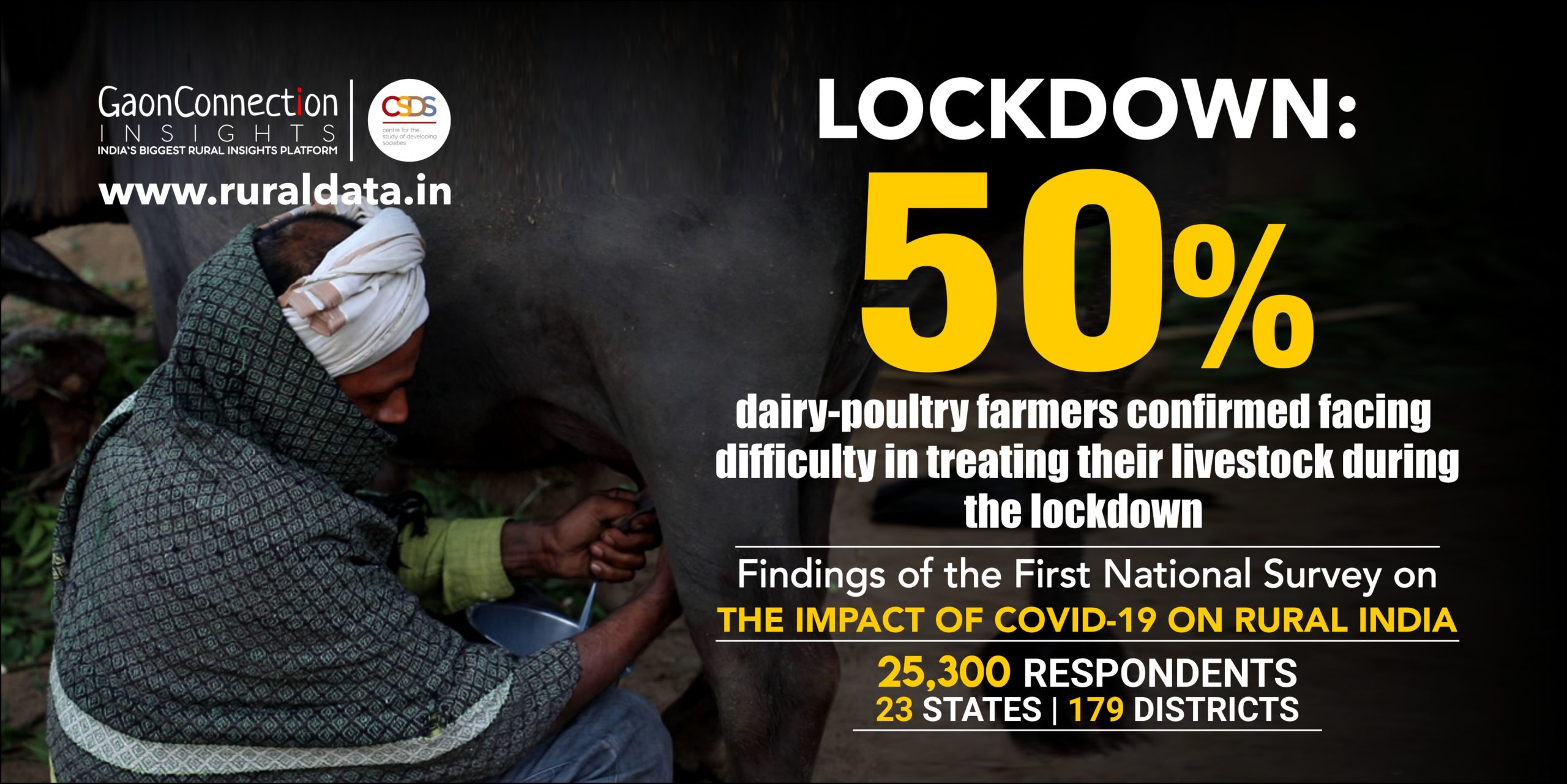
Farmers across many states like Maharashtra have opposed the move. In Maharashtra, the farmers’ organization ‘ Swabhiman Shetkari Sangathan ‘ has held demonstrations against milk prices and milk powder imports.
“Dairy farmers have already suffered a lot in the lockdown and now the government is buying milk powder from outside instead of helping them. Our organisation is constantly agitating against it,” Raju Shetty, president of the organization, told Gaon Connection.
The dairy farmers also found it difficult to procure cattle feed. The Ministry of Home Affairs had on March 26 allowed the movement of cattle feed, but farmers told Gaon Connection that they had been unable to get it. The feed available for sale was marketed at double the price, they said..
In Gaon Connection survey, 29 per cent of the people admitted they had difficulty in getting fodder, while 64 per cent said they had not faced any problem, (31 per cent of them had received fodder, but in very small quantities) and eight per cent did not respond.
“We had a lot of difficulty in getting cattle feed and fodder,” Naveen Kumar, a dairyfarmer at Bishanpur village in Araria district of Bihar said. The lockout had delayed the harvesting of wheat due to which the dairy farmers were not able find hay.
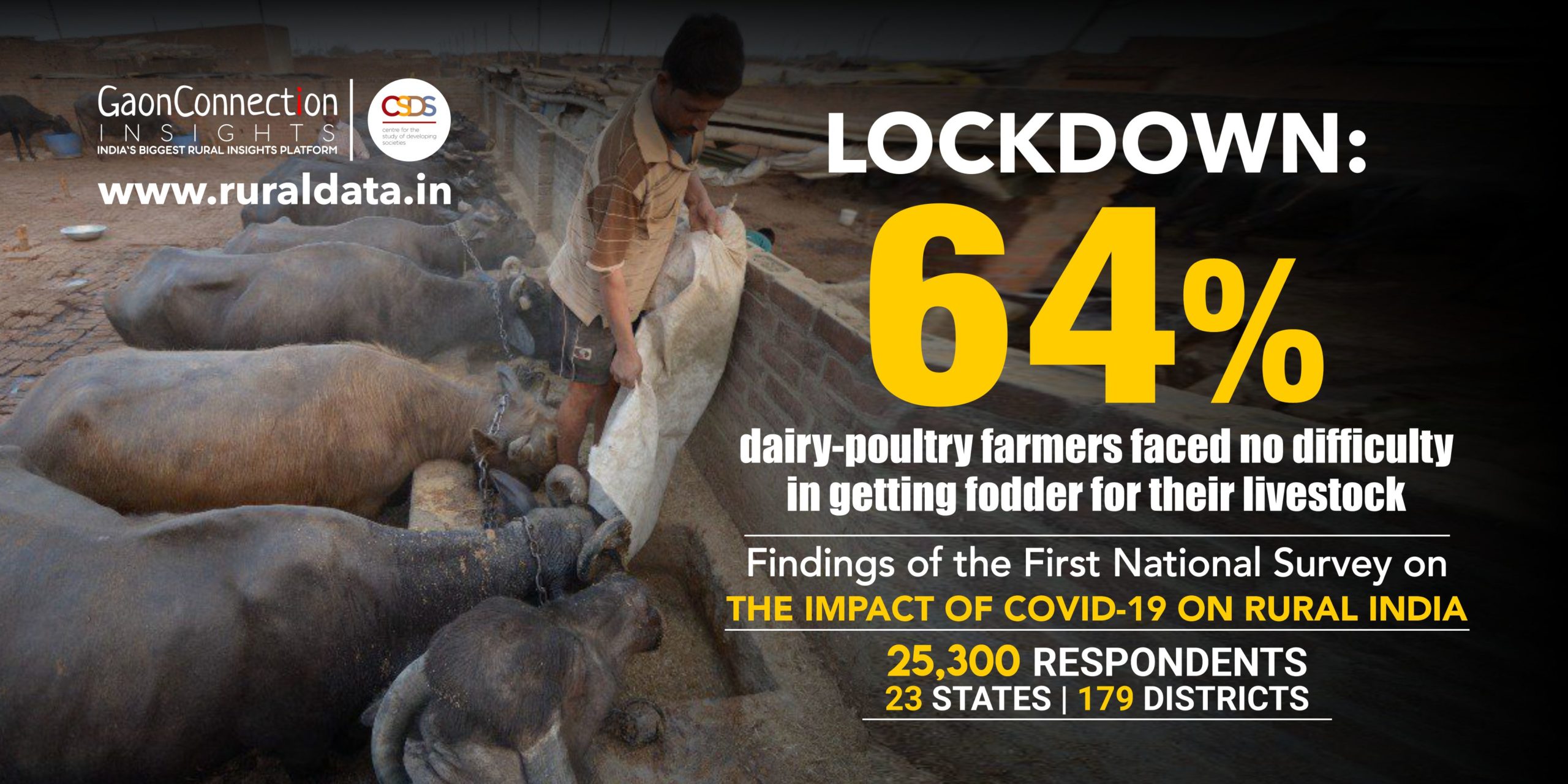
“The production of cattle feed in the lockdown was absolutely minimal due to absence of labourers and difficulties in transportation of finished goods. Besides, the police on the border of the districts did not allow entry or exit. Shopkeepers sold their stock at double the price,” Yatindra Yadav, director of a private company supplying cattle feed in several districts of UP and MP, said.
The people of Gurjar community in Uttarakhand, Himachal Pradesh and Jammu also trade milk, too suffered but on a different issue. A number of Muslim Gurjar families live near Rajaji National Park in Dehradun, Uttarakhand were hit after the Tabligi Jamaat case. “Before the lockdown, we used to sell 60-70 litres of milk, but in the lockdown, people stopped taking milk from us. People feared if they took milk from us, they would get Corona virus,” Liaqat said.
The survey methodology
The national survey conducted by India’s largest rural media institution, Gaon Connection, was conducted all over India in consultation with the public policy programme of the Centre for the Study of Developing Societies (CSDS), the country’s premier research institution in Delhi.
The survey was conducted among 25,371 people.The states where the survey was conducted included Rajasthan, Punjab, Haryana, Himachal Pradesh, Uttarakhand, Bihar, Uttar Pradesh, Jharkhand, West Bengal, Sikkim, Assam, Arunanchal Pradesh, Manipur, Tripura, Odisha, Kerala, Maharashtra, Gujarat, Madhya Pradesh and Chandigarh. Besides, surveys were also conducted in Jammu and Kashmir, Ladakh, Andaman and Nicobar Islands.
In all these states, the main breadwinner of the house was interviewed and a separate survey was conducted for the lockdown returnees with 963 respondents. The survey’s estimated sample size was 25,000, wherein the interviews were fixed in proportion to the states.
Of the total respondents, 79.1 per cent were men and 20.1 per cent were women. 53.7 per cent of those surveyed were between 26 and 45 years old. Of these, 33.1 per cent were either illiterate or only educated below primary level, 15 per cent were graduates. The surveyed 43 per cent people were poor, 24.9 per cent lower class and 25 per cent of the respondents had belonged to the middle income group.
The entire survey was taken up by the surveyors of Gaon Connection with the help of smart phones through the Face to Face app. During the entire survey, the COVID guidelines (masks, proper distance, hand sanitizer) etc. were strictly adhered to.
“Based on the diversity, breadth and sample size of the survey, I can definitely say that this is the first comprehensive survey of its kind, which focuses on the impact of lockdown on rural India,” asserted Sanjay Kumar, the professor at CSDS, New Delhi.
“In the entire survey, where the respondents are 100 per cent i.e., 25,000, the probability sampling method has been used and 95 per cent of the locations are likely to have a possible error of only +/ – 1 percent. Because a certain and proportional numbers of samples have not been taken from all states and union territories according to their population, non-predictability sampling method has been used in many logistic and COVID related issues and in such cases, we are not in a position to calculate the possible error,” Sanjay Kumar further said.

